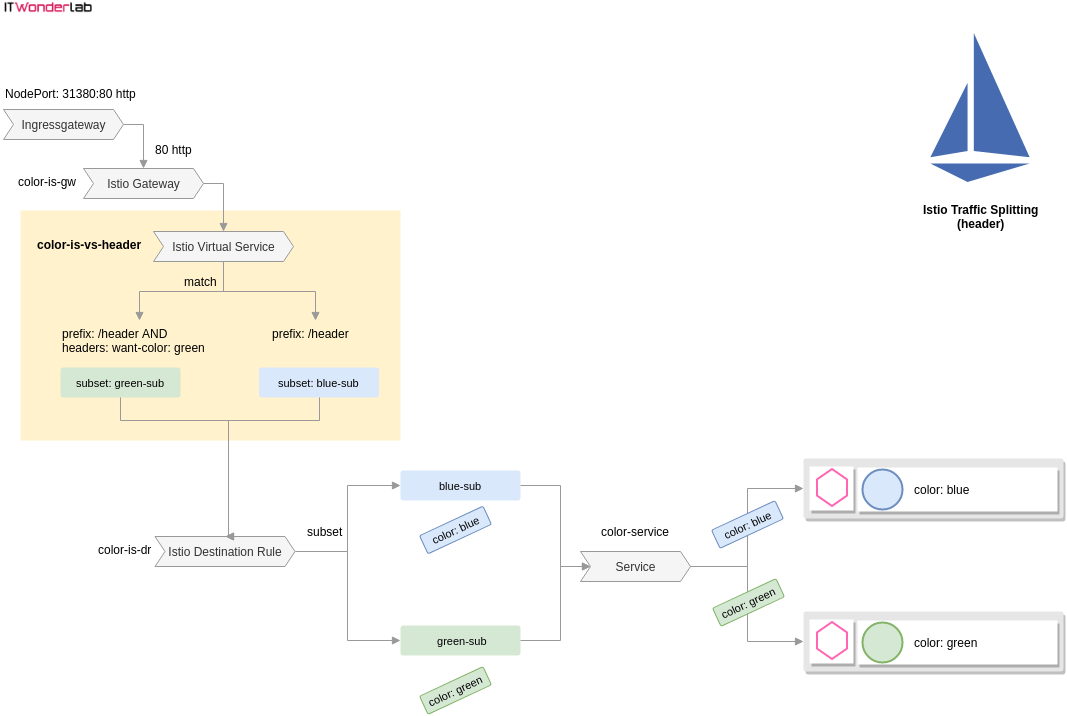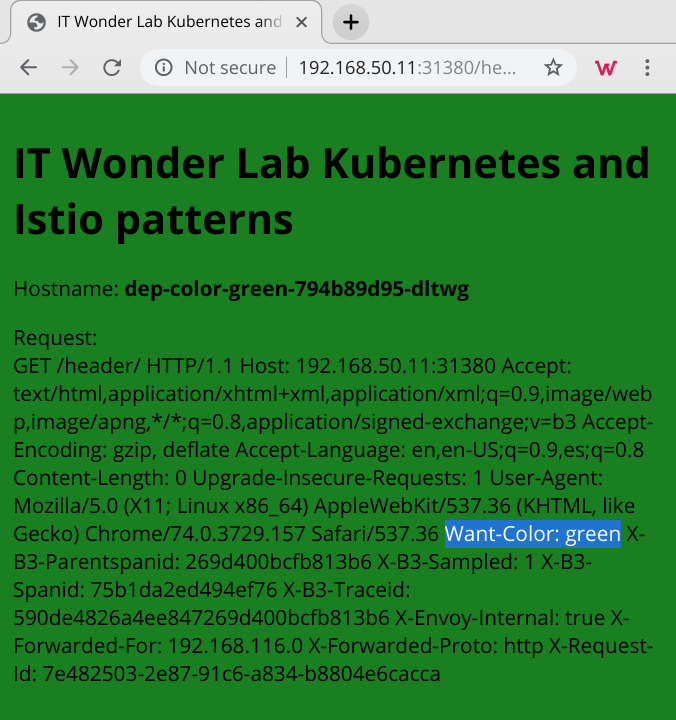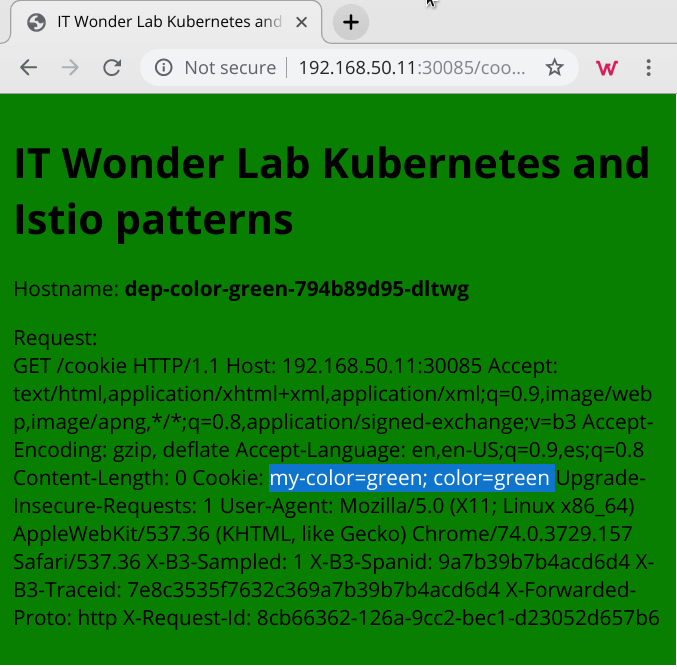Using Istio it is possible to distribute the traffic load using a request or client header as a switch to decide where to send the traffic. It can be useful in many situations like:
This tutorial shows how to define the needed Istio resources to distribute traffic based on the presence of a cookie or a header.
The examples shown in this Istio tutorial can be used in any Kubernetes cluster with Istio installed. If you need to run a full and free Kubernetes cluster on your development environment, please see my previous tutorials:
You will also need the Color web application to follow the example, it is a very small and simple application developed in Go that changes the background color based on the value of an environment variable.

See Istio Patterns: Traffic Splitting in Kubernetes (Canary Release) for instructions on how to build the application.
You can download the source code from IT Wonder Lab git repository, build the application, and create your own Docker image, or use a prebuilt image from the IT Wonder Lab Docker public repository.
The color-istio-gw-client-header.yaml defines 4 resources to accomplish an Istio Header Traffic Routing Deployment of the Color application:

In order to have a Header Based Routing decision in Istio only a single configuration element needs to be changed, the Istio Virtual Service.
Istio Virtual Service
It is a networking.istio.io/v1alpha3 VirtualService, shown with a yellow background on the above diagram.
The name of the Istio Virtual Service has been changed so that the previous Canary Deployment can still work and is not replaced by this new definition.
The new is color-is-vs-header Istio Virtual Service is defined as:
apiVersion: networking.istio.io/v1alpha3
kind: VirtualService
metadata:
name: color-is-vs-header
spec:
hosts:
- "*"
gateways:
- color-is-gw
http:
- match:
- uri:
prefix: /header
headers:
want-color:
exact: green
route:
- destination:
host: color-service #Name of the service
subset: green-sub
- match:
- uri:
prefix: /header
route:
- destination: #Default (if match is false)
host: color-service #Name of the service
subset: blue-subThe "hosts" attribute is used to match traffic with any host header (represented with *).
The "http" attribute defines that this Virtual Service applies to HTTP traffic.
Indentation of match sections and route attributes are used to create an Istio Routing decision tree, in our header routing example, the match sections have the same indentation, meaning that the first match section will be evaluated, and if all conditions are true, the route will be applied. If any of the conditions fail, the next match section will be evaluated.
Istio decision tree:
The first "match" section will:
The second "match" section will only be evaluated if the first section is not true, it will:
The Istio Gateway, Kubernetes Service color-service, and Istio Destination Rule are the same as the ones defined for the Canary Deployment, shown here as a reference:
Create the objects in the Kubernetes Cluster with:
jruiz@XPS13:~/../istio-patterns$ kubectl apply -f color-istio-gw-client-header.yaml
Open a browser and visit the URL http://192.168.50.11:31380/header/
The background of the page will be always blue.
In order to access the green version, a client header needs to be added. If using Google Chrome a header can be added with the extension ModHeader.
Add the header want-color with the value green.

Reload the URL http://192.168.50.11:31380/header/ to see the green version:

Delete the header or change its name or value to go back to the blue version.
In order to have cookie-based Routing decisions in Istio, only a single configuration element needs to be changed, the Istio Virtual Service.
The color-istio-gw-client-cookie.yaml includes all the needed Istio objects.
The name of the Istio Virtual Service has been changed so that the previous Header-Based Deployment can still work and is not replaced by this new definition.
The new color-is-vs-cookie Istio Virtual Service is defined as:
apiVersion: networking.istio.io/v1alpha3
kind: VirtualService
metadata:
name: color-is-vs-cookie
spec:
hosts:
- "*"
gateways:
- color-is-gw
http:
- match:
- uri:
prefix: /cookie
headers:
cookie:
regex: ^(.\*?;)?(my-color=green)(;.\*)?$
route:
- destination:
host: color-service #Name of the service
subset: green-sub
- match:
- uri:
prefix: /cookie
route:
- destination: #Default (if match is false)
host: color-service #Name of the service
subset: blue-subThe new Istio decision tree checks for the existence of a cookie. Cookies are not much different than other client headers, the only difference is that a regular expression is needed to find the desired cookie inside the cookie header.
The first "match" section will:
The second "match" section will only be evaluated if the first section is not true, it will:
In order to access the green version, a cookie needs to be added. If using Google Chrome a cookie can be added with the extension Cookie-Editor.
Add the cookie my-color with the value green and reload the URL http://192.168.50.11:31380/header/ to see the green version.

The screenshot of the Color Applications shows, highlighted in blue, two Cookies, one of the cookies is the my-color=green cookie set by us using the Google Chrome extension EditThisCookie and the other cookie color=green was set by the application and sent to the client.

IT Wonder Lab tutorials are based on the diverse experience of Javier Ruiz, who founded and bootstrapped a SaaS company in the energy sector. His company, later acquired by a NASDAQ traded company, managed over €2 billion per year of electricity for prominent energy producers across Europe and America. Javier has over 25 years of experience in building and managing IT companies, developing cloud infrastructure, leading cross-functional teams, and transitioning his own company from on-premises, consulting, and custom software development to a successful SaaS model that scaled globally.